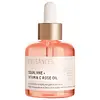What's inside
What's inside
 Key Ingredients
Key Ingredients

 Benefits
Benefits

 Concerns
Concerns

 Ingredients Side-by-side
Ingredients Side-by-side

Hordeum Vulgare Leaf Juice
EmollientPropanediol
SolventWater
Skin ConditioningSilybum Marianum Ethyl Ester
Skin ConditioningGalactoarabinan
Glycerin
HumectantSalix Alba Bark Extract
AstringentCetearyl Olivate
Simmondsia Chinensis Seed Oil
EmollientSqualane
EmollientSorbitan Olivate
EmulsifyingButter Glycerides
Skin ConditioningIsopropyl Shea Butterate
EmollientLactobacillus Ferment
Skin ConditioningLeuconostoc Ferment Filtrate
AntimicrobialSolanum Lycopersicum Fruit Extract
AntioxidantLactic Acid
BufferingVaccinium Myrtillus Fruit/Leaf Extract
AstringentSaccharum Officinarum Extract
MoisturisingCitrus Aurantium Dulcis Fruit Extract
MaskingCitrus Limon Fruit Extract
MaskingAcer Saccharum Extract
Skin ConditioningCitric Acid
BufferingTerminalia Ferdinandiana Fruit Extract
AntioxidantLithospermum Erythrorhizon Root Extract
Skin ConditioningHippophae Rhamnoides Oil
EmollientPlukenetia Volubilis Seed Oil
EmollientSaccharide Isomerate
HumectantTasmannia Lanceolata Fruit/Leaf Extract
AntioxidantArnica Montana Extract
Skin ConditioningBorago Officinalis Leaf Extract
Skin ConditioningCalendula Officinalis Flower Extract
MaskingMedicago Sativa Extract
TonicSpiraea Ulmaria Extract
AstringentSambucus Nigra Fruit Extract
AstringentOlea Europaea Fruit Oil
MaskingTocopherol
AntioxidantCaprylic/Capric Triglyceride
MaskingCetyl Palmitate
EmollientSorbitan Palmitate
EmulsifyingSclerotium Gum
Emulsion StabilisingAroma
Sodium Phytate
Sodium Citrate
BufferingMica
Cosmetic ColorantAlcohol
AntimicrobialCI 77891
Cosmetic ColorantCI 77491
Cosmetic ColorantCitral
PerfumingLimonene
PerfumingLinalool
PerfumingGeraniol
PerfumingBenzyl Benzoate
AntimicrobialHordeum Vulgare Leaf Juice, Propanediol, Water, Silybum Marianum Ethyl Ester, Galactoarabinan, Glycerin, Salix Alba Bark Extract, Cetearyl Olivate, Simmondsia Chinensis Seed Oil, Squalane, Sorbitan Olivate, Butter Glycerides, Isopropyl Shea Butterate, Lactobacillus Ferment, Leuconostoc Ferment Filtrate, Solanum Lycopersicum Fruit Extract, Lactic Acid, Vaccinium Myrtillus Fruit/Leaf Extract, Saccharum Officinarum Extract, Citrus Aurantium Dulcis Fruit Extract, Citrus Limon Fruit Extract, Acer Saccharum Extract, Citric Acid, Terminalia Ferdinandiana Fruit Extract, Lithospermum Erythrorhizon Root Extract, Hippophae Rhamnoides Oil, Plukenetia Volubilis Seed Oil, Saccharide Isomerate, Tasmannia Lanceolata Fruit/Leaf Extract, Arnica Montana Extract, Borago Officinalis Leaf Extract, Calendula Officinalis Flower Extract, Medicago Sativa Extract, Spiraea Ulmaria Extract, Sambucus Nigra Fruit Extract, Olea Europaea Fruit Oil, Tocopherol, Caprylic/Capric Triglyceride, Cetyl Palmitate, Sorbitan Palmitate, Sclerotium Gum, Aroma, Sodium Phytate, Sodium Citrate, Mica, Alcohol, CI 77891, CI 77491, Citral, Limonene, Linalool, Geraniol, Benzyl Benzoate
 Reviews
Reviews

Ingredients Explained
These ingredients are found in both products.
Ingredients higher up in an ingredient list are typically present in a larger amount.
This ingredient is an emollient, solvent, and texture enhancer. It is considered a skin-softener by helping the skin prevent moisture loss.
It helps thicken a product's formula and makes it easier to spread by dissolving clumping compounds.
Caprylic Triglyceride is made by combining glycerin with coconut oil, forming a clear liquid.
While there is an assumption Caprylic Triglyceride can clog pores due to it being derived from coconut oil, there is no research supporting this.
Learn more about Caprylic/Capric TriglycerideGeraniol is used to add fragrance/parfum to a product. It is the main component of citronellol. It is a monoterpenoid and an alcohol.
Monoterpenes are naturally found in many parts of different plants.
Geraniol can be found in many essential oils including Rose Oil and Citronella Oil. The scent of Geraniol is often described as "rose-like". Many foods also contain Geraniol for fruit flavoring.
Geraniol can irritate the skin when exposed to air. However, irritation depends on the ability of geraniol to penetrate into the skin. In general, geraniol is not able to penetrate skin easily.
Geraniol is colorless and has low water-solubility. However, it is soluble in common organic solvents.
Like citronellol, it is a natural insect repellent.
2,6-Octadien-1-ol, 3,7-dimethyl-, (2E)-
Learn more about GeraniolSqualane is an emollient that helps the skin hold onto moisture. It's an oily liquid that occurs naturally in certain types of fish and plant oils.
Because squalane boosts hydration in the skin, it also comes with plenty of benefits: it is an antioxidant and can help fight free radicals and skin damage. Squalane is also found to have a detoxifying effect when applied.
Squalane comes from squalene, which occurs naturally within the sebum of our skin. It is one of the oils our skin produces to keep itself hydrated. Squalane is the hydrogenated version of squalene and has a longer shelf life.
Research shows that squalane is non-irritating (even at 100% concentration).
In general, it's a fantastic ingredient. It does a great job at hydrating the skin, and it's suitable for those with sensitive skin.
The source of squalane may impact malassezia / fungal acne. This is because olive oil derived squalane can contain impurities such as fatty acids and plant waxes. Sugarcane derived squalane is recommended for anyone with malassezia concerns.
Is squalane vegan?
This depends on the source. Squalane can be derived from both plants and animals. Most squalane used in skincare comes from plants.
Please note: the source of squalane is only known if disclosed by the brand. We recommend reaching out to the brand if you have any questions about their squalane.
Read more about squalene with an "e".
Is squalane an oil?
Squalane is often called an oil, but it’s technically not; it’s a hydrocarbon, meaning it’s only made of carbon and hydrogen, unlike true oils which are triglycerides made of fatty acids and glycerol.
The term “oil-free” isn’t regulated, so companies can define it however they want. Some exclude all oils, while others just avoid mineral oil or comedogenic oils.
While some people avoid oils thinking they cause breakouts, the right kind of oil (or oil-like ingredient like squalane) can actually help balance and hydrate your skin. It’s worth testing out simple oils or squalane to see what works best for your skin.
Learn more about Squalane